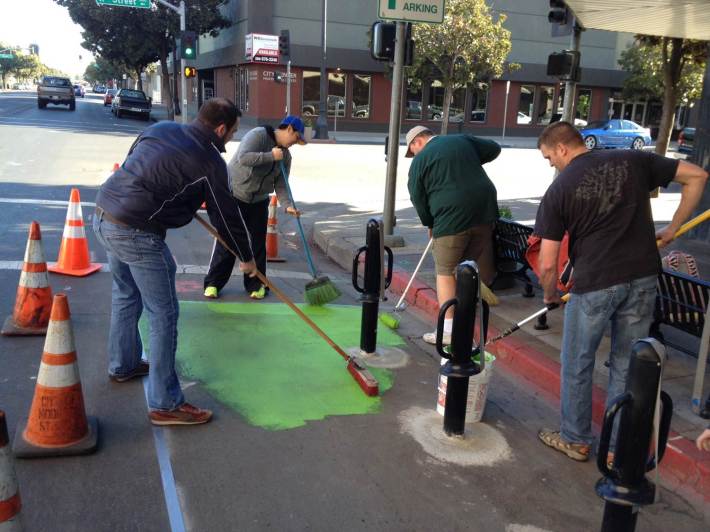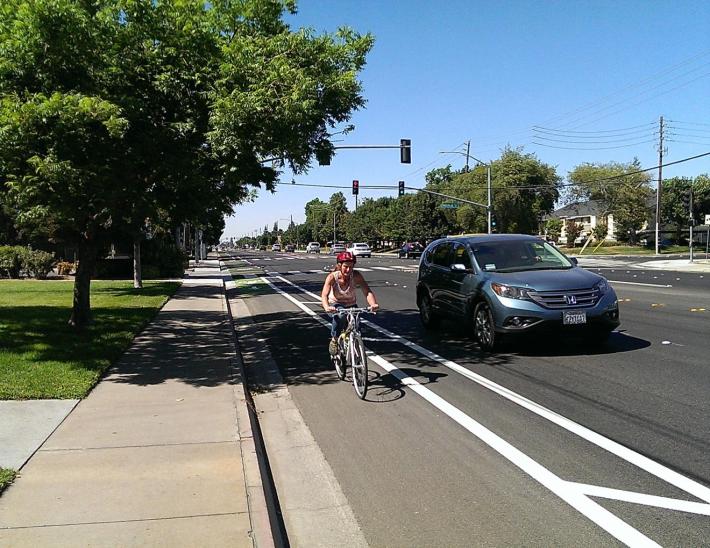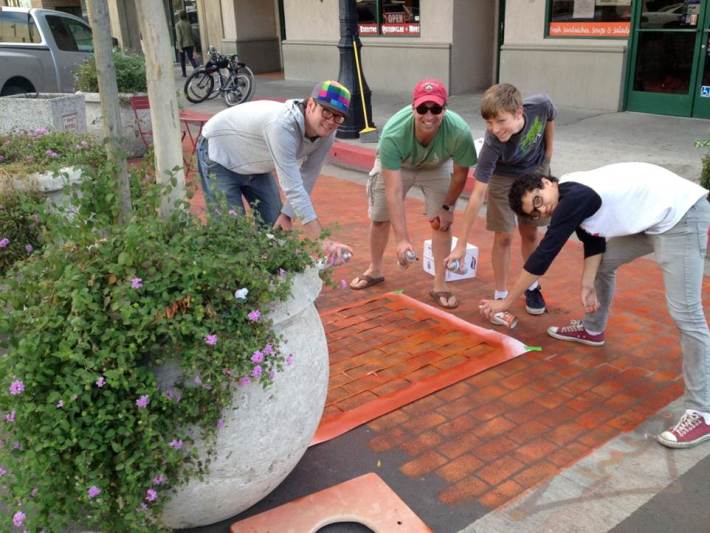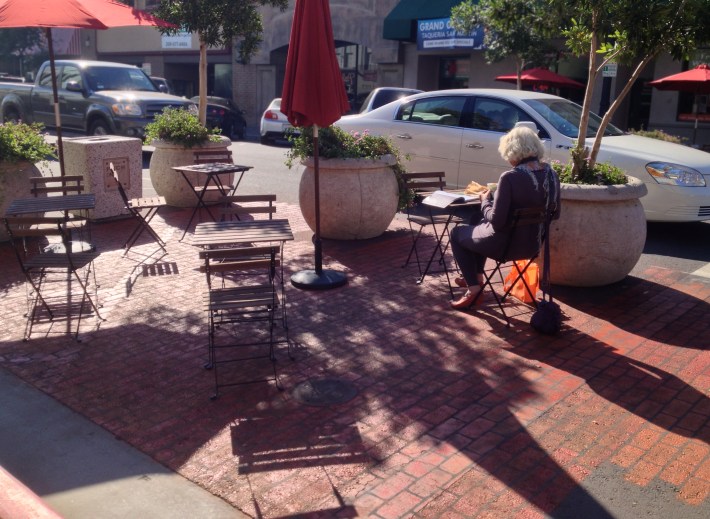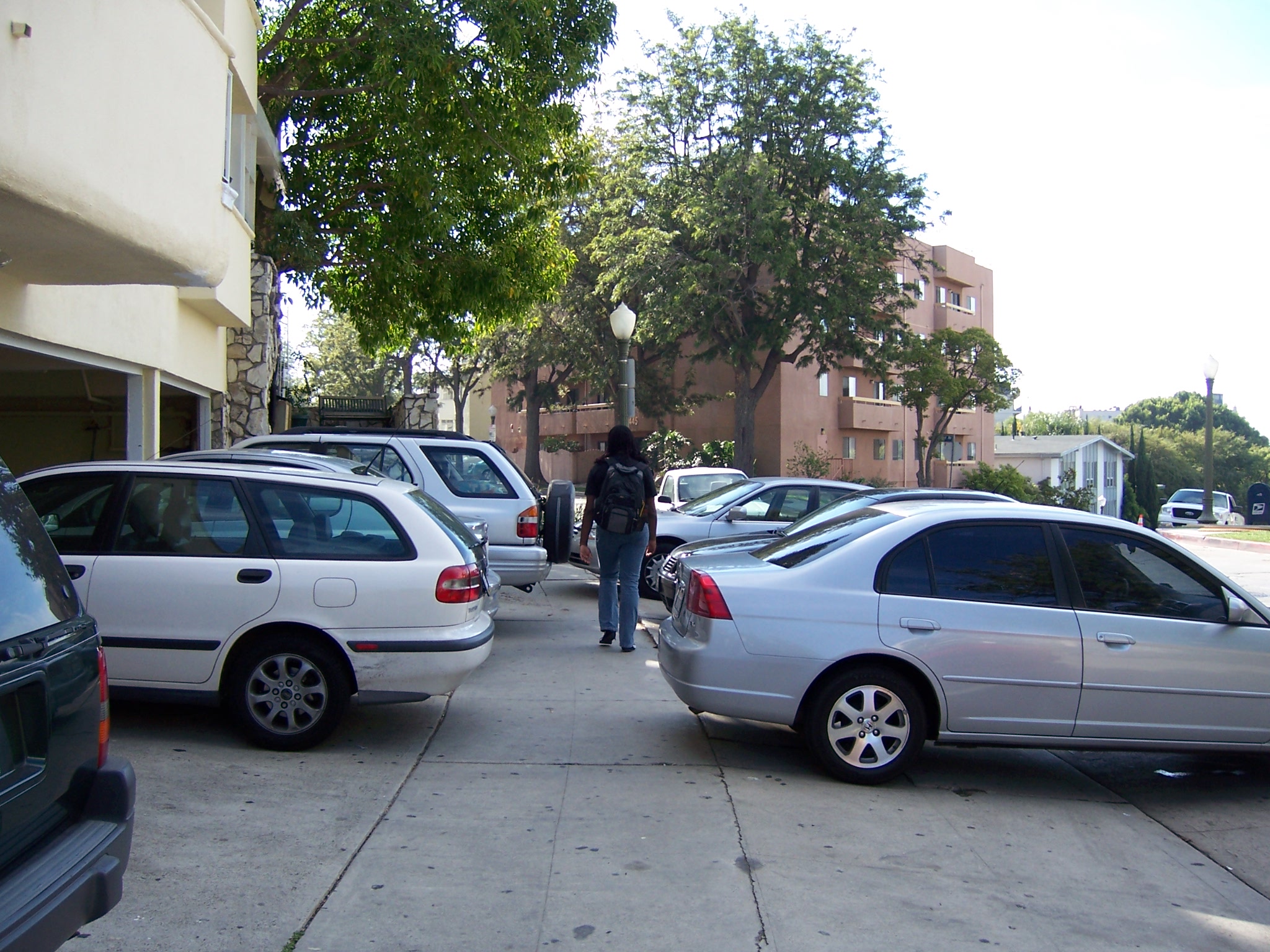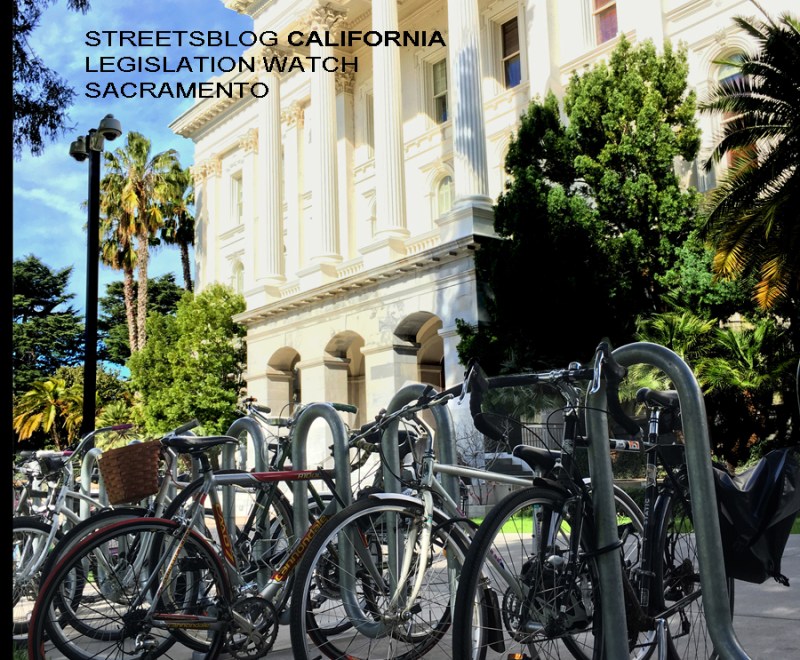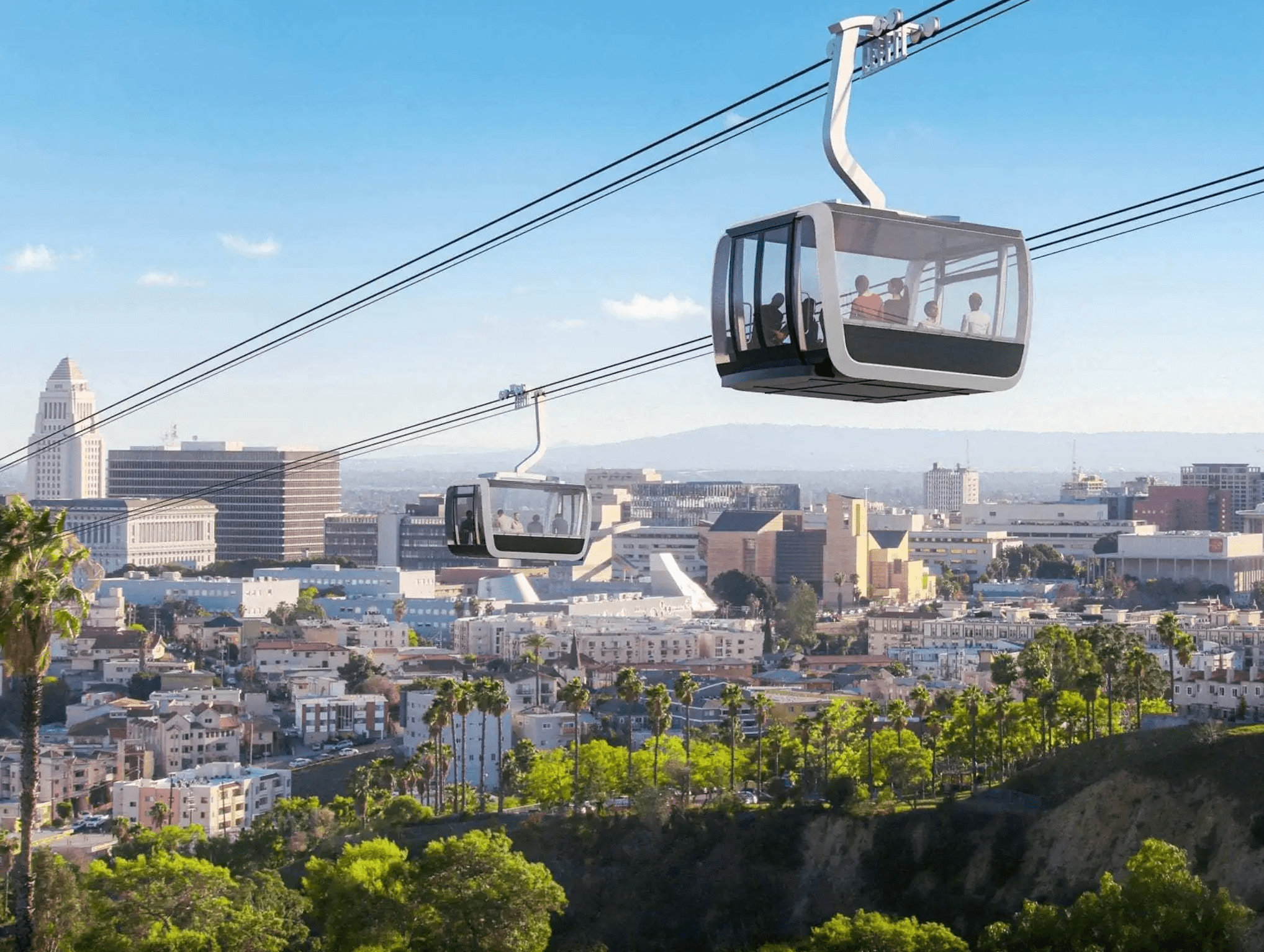Modesto, California: A Model for a Bicycle-Friendly City?
8:45 AM PDT on May 27, 2015
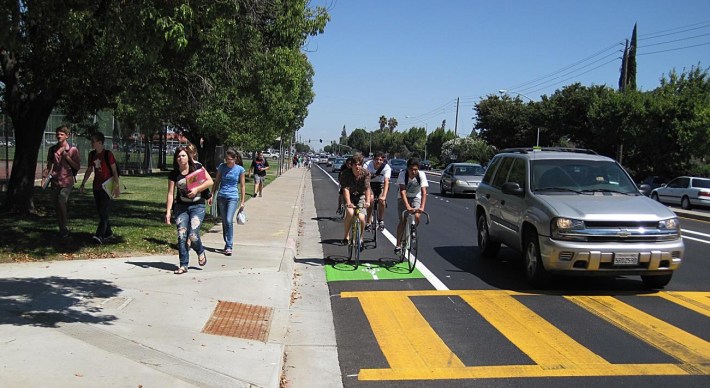
The California central valley town of Modesto is not usually high on anyone's list of cities embracing cutting-edge pedestrian and bicycle infrastructure. But that may change soon.
Modesto is one of the oldest cities in California, but like other central valley towns, it grew to accommodate car travel, with wide, fast streets, plenty of parking, and little attention given to other modes. In fact, the city may be best known as the setting for American Graffiti, George Lucas' nostalgic look at teenagers in a world of cheap gas and oversized cars.
In recent years, however, the city has been quietly applying Complete Streets principles on its roads. It has added buffered bike lanes when it repaved, built roundabouts at major intersections, added bike parking corrals in thoughtful ways, and created temporary plazas with the idea that once people experience them they will want to make them permanent.
And last month the City Council approved a project that includes a road diet on College Avenue and a curb-protected, two-way bike lane along nearby 9th Street. The project will connect two campuses of Modesto Junior College to relatively new bike lanes on Briggsmore Avenue, considerably adding to the city's bike network. This project alone will put Modesto at the forefront of bike-friendly infrastructure in California, ahead of other cities where advocates struggle to convince planners and planners struggle to convince the public that safer street designs will work for everyone.
The road diet passed the city council easily, after a short debate and with only one member voting against it. The whole project is now in the contract bidding process, and the city hopes to finish construction before summer is over.
That Modesto is embracing these changes is the result of a combination of factors, foremost among them being a forward-thinking city department: Transportation, Engineering and Design, also know as TED. Planners and engineers at TED give credit to a supportive City Council and to Modesto Mayor Garrad Marsh, who has been a strong proponent of a bicycle friendly city. Marsh has said he wants Modesto to earn a higher ranking as a Bicycle Friendly City from the League of American Bicyclists (it currently rates an “Honorable Mention”). He created a Bicycle Advisory Committee for the city, and has also made sure local funding was lined up for the College Avenue and 9th Street improvements.
These projects show that Modesto is shifting “from the old-school thinking to multimodal planning that accommodates all users, including bikes and pedestrians,” said Michael Sacuskie, a city engineer that has been working to improve its bicycle and pedestrian facilities. “Five years ago, I would never have thought I'd be doing this.” His department installed its first on-street bike parking corral last year, in front of a coffee shop popular with cyclists, and with the full support of the downtown merchants. The Modesto Bee lauded the project for, among other things, not costing much: the city had already purchased the bike racks years ago, and used surplus green paint to highlight the on-street corral.
Since then, several more bike parking corrals have been installed on the streets in Modesto's downtown. “Our philosophy,” said TED senior planner Josh Bridegroom, “is that you ride your bike on the street, and you should park your bike on the street. The corrals send a message that bikes belong.”
The College Avenue road diet will take a wide, fast arterial and turn it into something quite different. Five lanes of traffic will be reduced to three, creating a median with left turn lanes and safe areas for pedestrians to wait for gaps in traffic. Parking-protected bike lanes will be built in spots where there are no driveway conflicts, of which College Avenue has a several-block stretch. Other sections will have buffered bike lanes, with a three-foot painted separation between bikes and traffic. A transit hub will combine several bus stops that took up long sections of curb space into one pedestrian-friendly waiting zone. Pedestrian crossings will be improved with crosswalks and medians, and green paint will be used at conflict zones to help drivers and bicyclists understand where they should be.
Bridegroom calls College Avenue “a poster child for a road diet,” with its wide lanes, few driveways, busy but not congested car traffic, and connections between the local college and a major east-west arterial that already has bike lanes.
TED has also, in the past three years or so, found a way to use the city's repavement plan to improve conditions for bicyclists. Because, like everywhere else in the state, funding for maintenance is running low, the department had to get the most utility out of the funds it did spend. So when the city repaved Briggsmore Avenue, a major east-west artery, it narrowed the lanes and added buffered bike lanes. Oakdale Road and Sylvan Avenue received similar treatments when they were repaved, and thus the bike network has been growing at a very low cost to the city.
Another recent project, a parklet--or, more accurately, a painted, on-street plaza--took advantage of some underused space at the intersection of 10th and J streets.
“We saw an opportunity there,” said Bridegroom. The intersection was very wide, but couldn't be used for parking because of the way nearby diagonal parking had been designed. It also wasn't readily available for driving, so in collaboration with the Downtown Modesto Partnership—a collaborative group including business owners and others interested in improving downtown—the city created a temporary plaza space over a weekend with the help of volunteers.
“We got some photo paper and cut out a brick template pattern, bought two cans of spray paint, bought some cheap bistro furniture at Ikea, and found some random pots that were lining the streets in other areas. We assembled them all to frame the space, and it turned out really nice,” said Bridegroom. The response was enthusiastic, and the following year a leadership class taught through the Chamber of Commerce adopted the plaza as their class project, raising over $20,000 to help make it permanent.
“The city is committed to providing materials and staff time to implement it,” said Bridegroom, “and we saved a lot of money by being smart about it. For example, instead of labor-intensive pavers, we're using stamped concrete patterns that look like pavers but are more cost effective. In the end we're looking at redoing the whole street for probably around $100,000, which is ridiculously cheap compared to similar projects elsewhere.”
“We're trying to initiate changes though smart low-cost enhancements that get people to think a little differently about what's possible,” he said.
The redesign includes some tricky placement of trees to add much-needed shade. Trees couldn't be planted in sidewalk cuts, because the sidewalks in this historic section of the city are hollow, with basements from adjacent buildings extending out to the property line. The complex utility lines under the street would have been prohibitively expensive to relocate, so the solution was to build deep planters, partially recessed into the pavement, to contain the trees and their roots.
The permanent plaza is currently under construction; its completion depends on several factors, including the timing of several local parades.
Public response has not always been supportive. When city engineers first proposed narrowing the lanes on Briggsmore, there was consternation among traffic engineers and the public. “They thought we were insane,” said Sacuskie, “but we knew we could get a speed reduction with narrower lanes.” The planners finally prevailed, and when the projects were completed, “no one even noticed that we'd narrowed the lanes. They said, 'Oh, you didn't end up doing that part, did you?' But we had,” he said.
“It's interesting when people react by saying, 'Why are you building these? I never see any bikes out there,'” said Vickey Dion, Acting City Engineer. “Well, yes, that's true--because it's too dangerous. They think that nobody rides bikes, assuming that because they don't. But as we put in more bike lanes, we see more people using them.”
Dion is proud of the work her team has put into the projects. “We're not just throwing something out there to see if it sticks,” she said. “They've ridden the buses, they've talked to the bus drivers, they walk out there and check out the traffic. They're paying attention to everything. I've been really impressed with how much information they've gathered.”
The results are impressive. At public meetings about the road diet and separated bike lanes, public opinion ran 70 percent in favor of the new designs.
Phillip Soares, an associate civil engineer at TED, points out that the public support didn't come easy. “It takes a lot of work; a lot of education and networking. Opposition has mostly come because these things are new; they've never seen anything like a parking-protected bike lane,” he said.
“I see how everyone is trying to make [Modesto] better,” he said, “And my job is to expedite that. We have to work together to make it happen.”
“But we're not just designing for the riders in spandex. We're designing facilities for the person with a basket on their bike, for students trying to get to school.”
In the end, “that's nicer for everybody,” he said.
Streetsblog California editor Melanie Curry has been thinking about transportation, and how to improve conditions for bicyclists, ever since commuting to school by bike long before bike lanes were a thing. She was Managing Editor at the East Bay Express, editor of Access Magazine for the University of California Transportation Center, and earned her Masters in City Planning from UC Berkeley.
Stay in touch
Sign up for our free newsletter
More from Streetsblog California
Thursday’s Headlines
CA youth speak out on climate: How LA Metro plans to spend $ from canceled 710 freeway; Watch out, illegal SF parkers, tickets are coming; More
Legislators Tackle AV, School Zone Safety
Are AVs freight trucks ready to be deployed on California roads with no one in them?
Metro Looks to Approve Torrance C Line Extension Alignment
Selecting the relatively low-cost hybrid alternative should help the oft-delayed South Bay C Line extension move a step closer to reality
What to Say When Someone Claims ‘No One Bikes or Walks in Bad Weather’
Yes, sustainable modes are more vulnerable to bad weather. But that's why we should invest more in them — not less.
Wednesday’s Headlines
Road project leaves Half Moon Bay residents without access; Kern County residents concerned about a carbon capture plan; Who works from home in the Bay Area? More
